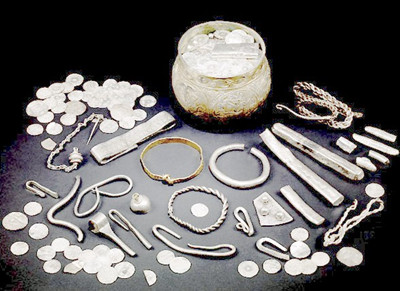The re-conquest of the Viking territories by the Anglo-Saxons was the great event of tenth-century Britain, and our treasure both pinpoints one tiny part of this national epic, and connects it to the immense world of Viking trade.
这百年间英格兰最重大的历史事件便是盎格鲁-撒克逊人逐渐夺回维京人所占领的土地。本节中的物品不但精准地反映出英格兰历史中的这一篇章,同时也与维京人巨大的贸易网络相连接。
The hoard was found in the winter of 2007.
这处宝藏是于2007年冬天。
Here's father and son, David and Andrew Whelan, who were metal-detecting in a field to the south of Harrogate, in north Yorkshire.
戴维·惠兰和安德鲁·惠兰父子在约克郡北部哈罗盖特南方的田野里探测金属时无意中发现的。
The hoard that David and Andrew Whelan had found was contained in this beautifully worked silver bowl, about the size of a small melon.
这批戴维·惠兰和安德鲁·惠兰父子发现的财物是装在一个做工精美、约小甜瓜大小的银碗里。
Astonishingly, it contained over 600 coins, all silver, and roughly the same size as a modern pound coin, but wafer thin.
令人惊讶的是,碗里竟然盛着600多枚银币,每枚直径接近现代的一英镑硬币,但极薄。
They're mostly from Anglo-Saxon territory, but there are also some Viking coins produced in York, as well as exotic imports from western Europe and Central Asia.
银币大部分来自盎格鲁-撒克逊王国,小部分由维京人在约克制造,还有一些源自西欧或中亚。
Along with the coins was jewellery: arm-rings-one gold and five silver ones.
和银币一起出土的还有一个金臂环、6个银臂环,以及被一些考古学家称为“碎银”的银块:
And then, there's the ingredient that makes it absolutely certain that this is not an Anglo-Saxon but a Viking hoard;
这一因素也使考古学家确信这是维京人而非盎格鲁-撒克逊人的宝藏。
there's what we call hack silver-chopped-up fragments of silver brooches and rings and thin silver bars, mostly about an inch long, that the Vikings used as currency.
它们是胸针、指环和窄银条的碎块,多为数厘米长,曾被维京人用作货币。
译文属可可原创,仅供学习交流使用,未经许可请勿转载













